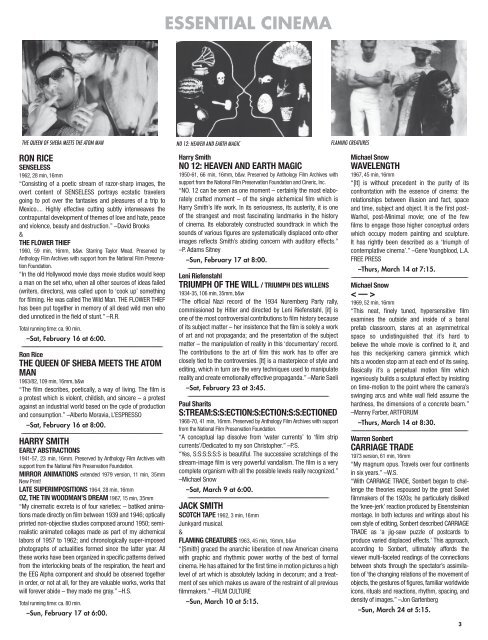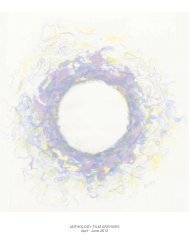quarterly pdf - Anthology Film Archives
quarterly pdf - Anthology Film Archives
quarterly pdf - Anthology Film Archives
Create successful ePaper yourself
Turn your PDF publications into a flip-book with our unique Google optimized e-Paper software.
THE QUEEN OF SHEBA MEETS THE ATOM MAN NO 12: HEAVEN AND EARTH MAGIC<br />
RON RICE<br />
SENSELESS<br />
1962, 28 min, 16mm<br />
“Consisting of a poetic stream of razor-sharp images, the<br />
overt content of SENSELESS portrays ecstatic travelers<br />
going to pot over the fantasies and pleasures of a trip to<br />
Mexico.... Highly effective cutting subtly interweaves the<br />
contrapuntal development of themes of love and hate, peace<br />
and violence, beauty and destruction.” –David Brooks<br />
&<br />
THE FLOWER THIEF<br />
1960, 59 min, 16mm, b&w. Starring Taylor Mead. Preserved by<br />
<strong>Anthology</strong> <strong>Film</strong> <strong>Archives</strong> with support from the National <strong>Film</strong> Preservation<br />
Foundation.<br />
“In the old Hollywood movie days movie studios would keep<br />
a man on the set who, when all other sources of ideas failed<br />
(writers, directors), was called upon to ‘cook up’ something<br />
for filming. He was called The Wild Man. THE FLOWER THIEF<br />
has been put together in memory of all dead wild men who<br />
died unnoticed in the field of stunt.” –R.R.<br />
Total running time: ca. 90 min.<br />
–Sat, February 16 at 6:00.<br />
–––––––––––––––––––––––––––––––––––––––––––––––––––––––––––––––––––––––––––––––––––––––––––––––––––––––<br />
Ron Rice<br />
THE QUEEN OF SHEBA MEETS THE ATOM<br />
MAN<br />
1963/82, 109 min, 16mm, b&w<br />
“The film describes, poetically, a way of living. The film is<br />
a protest which is violent, childish, and sincere – a protest<br />
against an industrial world based on the cycle of production<br />
and consumption.” –Alberto Moravia, L’ESPRESSO<br />
–Sat, February 16 at 8:00.<br />
–––––––––––––––––––––––––––––––––––––––––––––––––––––––––––––––––––––––––––––––––––––––––––––––––––––––<br />
HARRY SMITH<br />
EARLY ABSTRACTIONS<br />
1941-57, 23 min, 16mm. Preserved by <strong>Anthology</strong> <strong>Film</strong> <strong>Archives</strong> with<br />
support from the National <strong>Film</strong> Preservation Foundation.<br />
MIRROR ANIMATIONS extended 1979 version, 11 min, 35mm<br />
New Print!<br />
LATE SUPERIMPOSITIONS 1964, 28 min, 16mm<br />
OZ, THE TIN WOODMAN’S DREAM 1967, 15 min, 35mm<br />
“My cinematic excreta is of four varieties: – batiked animations<br />
made directly on film between 1939 and 1946; optically<br />
printed non-objective studies composed around 1950; semirealistic<br />
animated collages made as part of my alchemical<br />
labors of 1957 to 1962; and chronologically super-imposed<br />
photographs of actualities formed since the latter year. All<br />
these works have been organized in specific patterns derived<br />
from the interlocking beats of the respiration, the heart and<br />
the EEG Alpha component and should be observed together<br />
in order, or not at all, for they are valuable works, works that<br />
will forever abide – they made me gray.” –H.S.<br />
Total running time: ca. 80 min.<br />
–Sun, February 17 at 6:00.<br />
ESSENTIAL CINEMA<br />
Harry Smith<br />
NO 12: HEAVEN AND EARTH MAGIC<br />
1950-61, 66 min, 16mm, b&w. Preserved by <strong>Anthology</strong> <strong>Film</strong> <strong>Archives</strong> with<br />
support from the National <strong>Film</strong> Preservation Foundation and Cineric, Inc.<br />
“NO. 12 can be seen as one moment – certainly the most elaborately<br />
crafted moment – of the single alchemical film which is<br />
Harry Smith’s life work. In its seriousness, its austerity, it is one<br />
of the strangest and most fascinating landmarks in the history<br />
of cinema. Its elaborately constructed soundtrack in which the<br />
sounds of various figures are systematically displaced onto other<br />
images reflects Smith’s abiding concern with auditory effects.”<br />
–P. Adams Sitney<br />
–Sun, February 17 at 8:00.<br />
–––––––––––––––––––––––––––––––––––––––––––––––––––––––––––––––––––––––––––––––––––––––––––––––––––––––<br />
Leni Riefenstahl<br />
TRIUMPH OF THE WILL / TRIUMPH DES WILLENS<br />
1934-35, 106 min, 35mm, b&w<br />
“The official Nazi record of the 1934 Nuremberg Party rally,<br />
commissioned by Hitler and directed by Leni Riefenstahl, [it] is<br />
one of the most controversial contributions to film history because<br />
of its subject matter – her insistence that the film is solely a work<br />
of art and not propaganda; and the presentation of the subject<br />
matter – the manipulation of reality in this ‘documentary’ record.<br />
The contributions to the art of film this work has to offer are<br />
closely tied to the controversies. [It] is a masterpiece of style and<br />
editing, which in turn are the very techniques used to manipulate<br />
reality and create emotionally effective propaganda.” –Marie Saeli<br />
–Sat, February 23 at 3:45.<br />
–––––––––––––––––––––––––––––––––––––––––––––––––––––––––––––––––––––––––––––––––––––––––––––––––––––––<br />
Paul Sharits<br />
S:TREAM:S:S:ECTION:S:ECTION:S:S:ECTIONED<br />
1968-70, 41 min, 16mm. Preserved by <strong>Anthology</strong> <strong>Film</strong> <strong>Archives</strong> with support<br />
from the National <strong>Film</strong> Preservation Foundation.<br />
“A conceptual lap dissolve from ‘water currents’ to ‘film strip<br />
currents’/Dedicated to my son Christopher.” –P.S.<br />
“Yes, S:S:S:S:S:S is beautiful. The successive scratchings of the<br />
stream-image film is very powerful vandalism. The film is a very<br />
complete organism with all the possible levels really recognized.”<br />
–Michael Snow<br />
–Sat, March 9 at 6:00.<br />
–––––––––––––––––––––––––––––––––––––––––––––––––––––––––––––––––––––––––––––––––––––––––––––––––––––––<br />
JACK SMITH<br />
SCOTCH TAPE 1962, 3 min, 16mm<br />
Junkyard musical.<br />
&<br />
FLAMING CREATURES 1963, 45 min, 16mm, b&w<br />
“[Smith] graced the anarchic liberation of new American cinema<br />
with graphic and rhythmic power worthy of the best of formal<br />
cinema. He has attained for the first time in motion pictures a high<br />
level of art which is absolutely lacking in decorum; and a treatment<br />
of sex which makes us aware of the restraint of all previous<br />
filmmakers.” –FILM CULTURE<br />
–Sun, March 10 at 5:15.<br />
FLAMING CREATURES<br />
Michael Snow<br />
WAVELENGTH<br />
1967, 45 min, 16mm<br />
“[It] is without precedent in the purity of its<br />
confrontation with the essence of cinema: the<br />
relationships between illusion and fact, space<br />
and time, subject and object. It is the first post-<br />
Warhol, post-Minimal movie; one of the few<br />
films to engage those higher conceptual orders<br />
which occupy modern painting and sculpture.<br />
It has rightly been described as a ‘triumph of<br />
contemplative cinema’.” –Gene Youngblood, L.A.<br />
FREE PRESS<br />
–Thurs, March 14 at 7:15.<br />
–––––––––––––––––––––––––––––––––––––––––––––––––––––––––––––––––––––––––––––––––––––<br />
Michael Snow<br />
< — ><br />
1969, 52 min, 16mm<br />
“This neat, finely tuned, hypersensitive film<br />
examines the outside and inside of a banal<br />
prefab classroom, stares at an asymmetrical<br />
space so undistinguished that it’s hard to<br />
believe the whole movie is confined to it, and<br />
has this neckjerking camera gimmick which<br />
hits a wooden stop arm at each end of its swing.<br />
Basically it’s a perpetual motion film which<br />
ingeniously builds a sculptural effect by insisting<br />
on time-motion to the point where the camera’s<br />
swinging arcs and white wall field assume the<br />
hardness, the dimensions of a concrete beam.”<br />
–Manny Farber, ARTFORUM<br />
–Thurs, March 14 at 8:30.<br />
–––––––––––––––––––––––––––––––––––––––––––––––––––––––––––––––––––––––––––––––––––––<br />
Warren Sonbert<br />
CARRIAGE TRADE<br />
1973 version, 61 min, 16mm<br />
“My magnum opus. Travels over four continents<br />
in six years.” –W.S.<br />
“With CARRIAGE TRADE, Sonbert began to challenge<br />
the theories espoused by the great Soviet<br />
filmmakers of the 1920s; he particularly disliked<br />
the ‘knee-jerk’ reaction produced by Eisensteinian<br />
montage. In both lectures and writings about his<br />
own style of editing, Sonbert described CARRIAGE<br />
TRADE as ‘a jig-saw puzzle of postcards to<br />
produce varied displaced effects.’ This approach,<br />
according to Sonbert, ultimately affords the<br />
viewer multi-faceted readings of the connections<br />
between shots through the spectator’s assimilation<br />
of ‘the changing relations of the movement of<br />
objects, the gestures of figures, familiar worldwide<br />
icons, rituals and reactions, rhythm, spacing, and<br />
density of images.” –Jon Gartenberg<br />
–Sun, March 24 at 5:15.<br />
3




